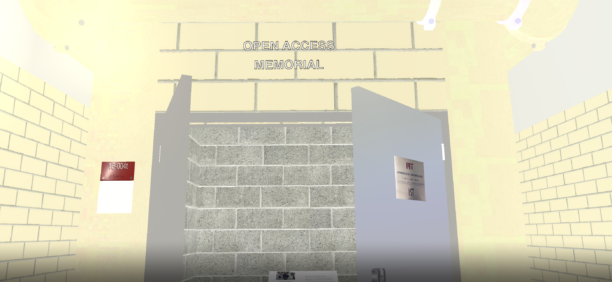


On January 6, 2011, Swartz was arrested by the MIT Police and an agent of the U.S. Secret Service. He was accused initially of breaking and entering with the intent to commit a felony: downloading a large number of academic articles from JSTOR. In the words of Lawrence Lessig, the Roy L. Furman Professor of Law and Leadership at Harvard Law School, “[JSTOR] declined to pursue their own action against Aaron, and they asked the government to drop its. MIT, to its great shame, was not as clear, and so the prosecutor had the excuse he needed to continue his war against the “criminal” who we who loved him knew as Aaron”. The prosecution came to an end with Aaron’s premature death in January 2013.
The AR Open Access Memorial shows the exterior and interior of the (originally unlocked) wiring and telephony closet where Aaron Swartz’s computer was found. The closet is known as 16-004t, and is located in the basement of Building 16.
Instead of cables, boxes and racks, there is just a book plinth in the closet, displaying the 2 pages of the Guerilla Open Access Manifesto, written by Swartz in 2008, and depicting an image of Aaron sitting on a tree. The Guerrilla Open Access Manifesto is a call to action, advocating for open access to academic research, particularly to articles and papers that are often hidden behind expensive paywalls. Swartz believed that the scholarly knowledge produced by academics, often funded by taxpayers, should be freely accessible to everyone, not locked behind costly subscription fees or pay-per-article systems.
In addition to reading Swartz’s Manifesto, the users of this experience can also explore the corridors and find a hidden surprise. The python code written by Swartz to download the JSTOR articles (called keepgrabbing.py) has been put in the wall behind the closet, establishing a direct dialogue between the Guerilla Open Access Manifesto and the code used to activate and execute his principles. This correlation of natural language and code can be seen in poetic terms. Aaron’s document is more than an invitation, it is an exercise of critical thinking against a system of control that puts knowledge in a prison. His manifesto and the code are two sides of the same coin that shed light on the life of Aaron, as well as the significance of the location in the Dorrance Building (16).
The building was named after John Thompson Dorrance, who invented a method to create condensed soup, and was president of the Campbell Soup Company. Since 1991, the lobby of the Dorrance Building has been a prime spot to place MIT’s indoor hacks.
